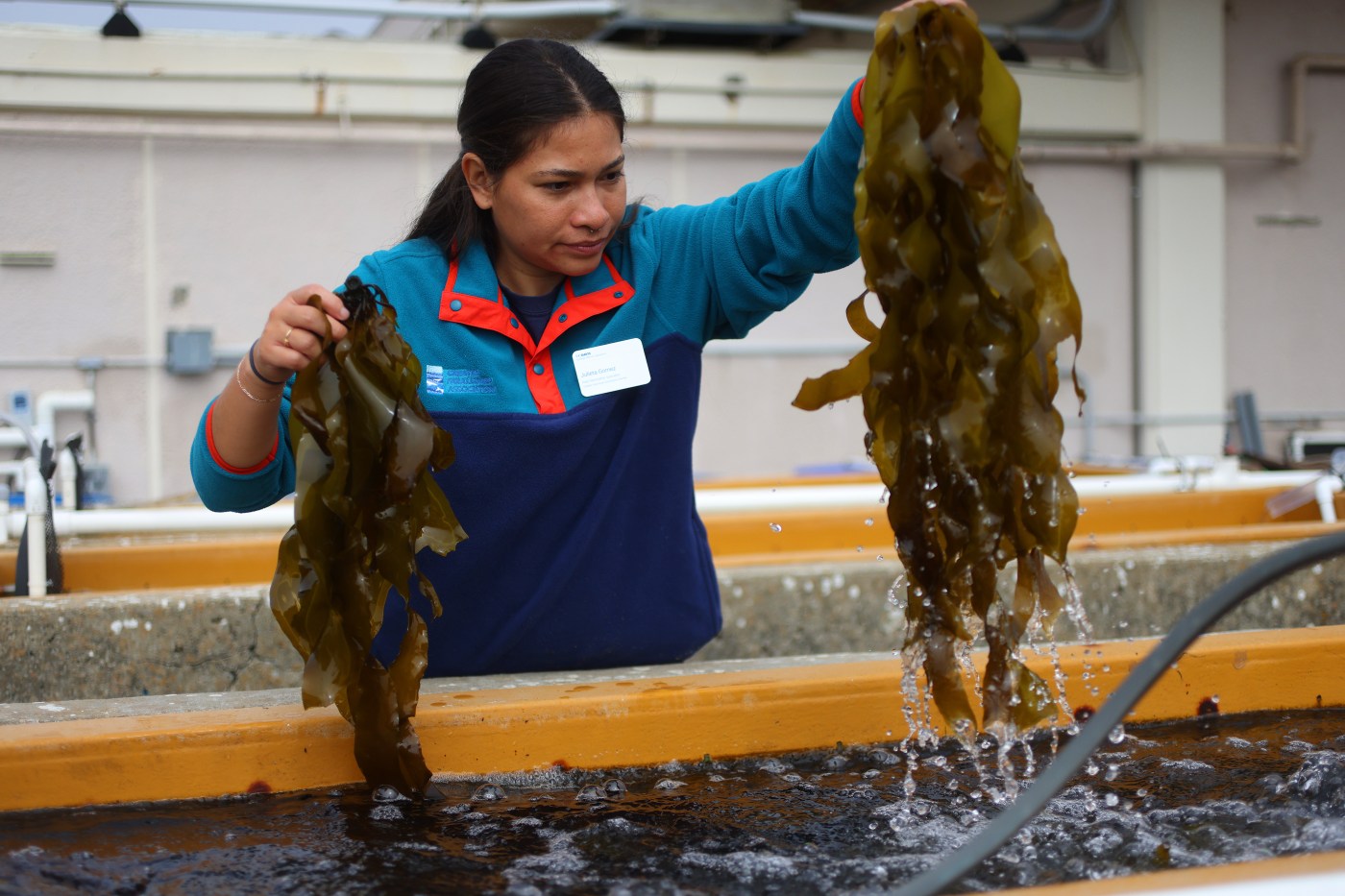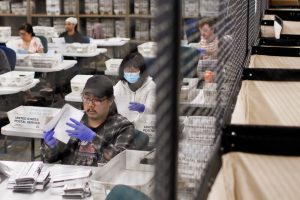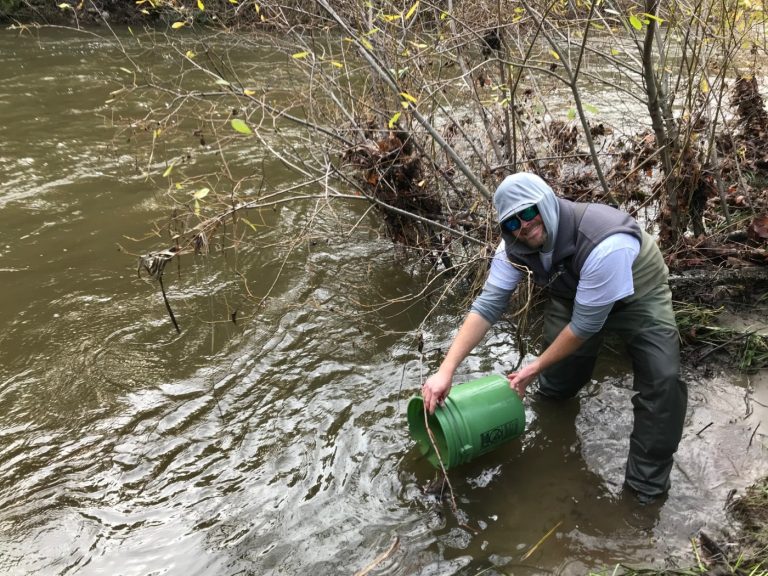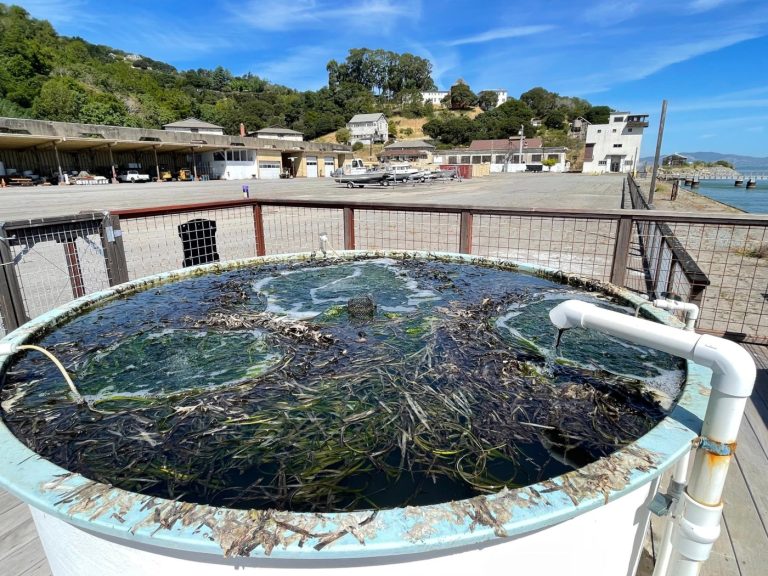The weathered UC Davis Marine Laboratory looms in thick fog on the edge of the ocean near Bodega Bay. Inside, an experiment is playing out that gives a badly-needed boost to Northern California’s kelp forests—underwater cathedrals of green and gold that nearly vanished from the north coast a decade ago.
In early October, marine biologist Julieta Gomez rolled up her sleeve, reached into a jug of tumbling salt water, and pulled out a spool of twine. On it grew dozens of bull kelp starts, each little more than a brown speck. Their destination: the ocean. When Gomez attached twine like this to the seabed this summer, more than 100 juvenile kelp stipes appeared within the month and began reaching for the surface.
“They’re looking amazing,” she said.
Thanks to Gomez and her team, kelp is rebounding for the first time in a decade along the Sonoma coast, if even on a small scale. Their research is also providing insights that may be used to protect Central California’s kelp forests south of San Francisco. These, like others, are threatened by climate change, which is contributing to extreme ocean temperatures seen in recent years.
“We’re having success,” said Brent Hughes, a professor of biology at Sonoma State University who is restoring kelp in Sonoma, Mendocino and Marin counties. “We’re growing kelp out in the ocean. And now we’re ready to really expand this.”
The past two summers, Gomez and her colleagues donned scuba gear and dove into a briny cove north of Bodega Bay, with the spools in hand. The site, Fort Ross Cove, was once home to a lush underwater forest that provided habitat for marine life, supported commercial fisheries and stored carbon. Now, the kelp is replaced by armies of purple sea urchins, a casualty of a vast kelp forest collapse that began in 2014.
Fueled by a marine heat wave that year that scientists dubbed “the blob,” and key predators absent, urchins devoured more than 90% of bull kelp forests in Northern California. South of the San Francisco Bay, however, healthier kelp forests still coat the coasts and give life to California’s iconic sea otters.
At Fort Ross Cove, the scientists unraveled these inoculated lines of twine and secured them to the seabed. The hope was that these specks of young kelp would grow into towering stalks, and by fall’s end, release millions of reproductive spores. At the same time, commercial fishermen hand-removed purple urchins by the hundreds of thousands, to protect any new kelp that might appear, and scientists released millions of spores themselves.
Other scientists are using similar tactics in Marin and Mendocino counties. The experiments are small, on the order of a few acres each, but the results are promising. At another cove in Sonoma County, a canopy of bull kelp expanded modestly over the summer.
The projects are collaborations between the federal government, researchers, and scientists like Gomez with the nonprofit Greater Farallones Association. The organization protects an expansive marine sanctuary home to humpback whales, throngs of seabirds and great white sharks. The $9.5 million initiative in Sonoma County is mostly funded by the U.S. National Oceanic and Atmospheric Administration, as well as fishing regulators and California’s state wildlife agency.
Bull kelp circulates in an outdoor tank at The UC Davis Coastal and Marine Sciences Institute’s Bodega Marine Laboratory on Wednesday, Oct 9, 2024 in Bodega Bay, Calif. Kelp forests vanished off the northern California coast a decade ago. A restoration project in Sonoma County is seeing success re-planting kelp along the coast. (Aric Crabb/Bay Area News Group)
The return of kelp forests would broadly benefit the waters of Northern California. That would also protect coastlines from erosion, store planet-warming carbon dioxide and support the beleaguered abalone and red urchin fisheries.
Even with the recent success, however, it remains to be seen if these mighty underwater forests will ever be restored to their former glory in Northern California, or how long that might take.
Broadly, there are far too many purple urchins for divers to bag on the seafloor. Urchin “barrens” are vast, stretching through Oregon, and their natural predators are absent from the north coast: Sunflower stars are locally extinct due to a mysterious disease, and sea otters — a keystone species — haven’t returned to this part of the coast since they were hunted to extinction in the 19th century. Now, great white sharks limit their expansion north of the San Francisco Bay.
Julieta Gomez a kelp restoration specialist holds a sea urchin at The UC Davis Coastal and Marine Sciences Institute’s Bodega Marine Laboratory on Wednesday, Oct 9, 2024 in Bodega Bay, Calif. Kelp forests vanished off the northern California coast a decade ago. A restoration project in Sonoma County is seeing success re-planting kelp along the coast. (Aric Crabb/Bay Area News Group)
“It’s a lot of work to put people in the water and remove enough sea urchins to facilitate recovery,” said Joshua Smith, a research scientist at the Monterey Bay Aquarium who studies kelp forest restoration.
Beneath the surface, these swaying kelp forests create habitats for sea stars, rockfish, abalone, and more. Globally, kelp forest collapse is becoming more common due to climate change, pollution, overharvesting, and other factors.
But so is restoration.
Scientists are protecting or expanding kelp forests in Baja California, Southern California, Oregon and Washington’s Puget Sound. Locally, Hughes is also restoring kelp at two sites in Mendocino County.
Gina Contolini, another kelp restoration specialist with the Greater Farallones Association who coordinates urchin removal, said more projects like these are cropping up as scientists increasingly focus on these underwater forests. Researchers in California are also tying kelp restoration to global climate initiatives to store “blue carbon” in marine foliage.
“Kelp is a hot topic right now,” she said.
The research in Sonoma County has shown that scientists can grow kelp on twine on the north coast, where vicious storms and sharks limit their work, Hughes said. The benefit of the twine is that kelp can grow above the reach of hungry urchins.
But the research also shows that kelp forests can regrow directly on the seabed if enough urchins are removed from the equation.
To that end, the project employs commercial divers to remove purple urchins from two coves. Among them is Erik Owen, a fisherman based in Bodega Bay who dove for red urchins before kelp forests collapsed, taking the fishery with them. Red urchin uni is a valuable commodity used in foods like sushi, but not purple urchin. After hungry purple urchins mow down kelp forest, they lay dormant on the sea bed in a starved condition, with little uni of value for divers.
In the last year, Owen and other divers have pulled roughly 650,000 urchins from Fort Ross Cove and another, Timber Cove, using only their hands or an underwater rake. The urchins are boated back to land and composted because they’re not a worthwhile food product.
They’ve made a big dent. But Contolini says there’s not much stopping purple urchins from crawling back into the research sites.
“There’s still millions of urchins at the larger site,” she said. “They’re just everywhere.”
People will always be slower at harvesting urchins than sunflower stars and sea otters, their natural predators. Both species are known to protect kelp forests, and enough sunflower stars can even convert urchin barrens back to forested canopies, said Jason Hodin, a research scientist with the University of Washington.
“A healthy kelp forest has both,” he said. “A functioning ecosystem has both.”
But scientists are still trying to understand the disease that has decimated sunflower stars in California, sea star wasting syndrome, since 2013.
It’s less clear if sea otters could also help convert barrens to bull kelp canopies. The Greater Farallones Association projects in Sonoma County don’t involve the possibility of sea otter restoration because these vast barrens of emaciated sea urchins couldn’t sustain otters, according to its official plan.
However, sea otters played an instrumental role in restoring kelp forests in Alaska after their reintroduction in the 1960s. Smith, the Monterey Aquarium researcher, said that example is comparable to Northern California.
It’s a controversial topic. While environmentalists cheer the return of this keystone species, commercial fishermen are anxious because otters are voracious feeders on valuable catch like Dungeness crab and abalone, along with urchins. However, the U.S. Fish and Wildlife Service concluded that reintroduction would be ecologically feasible, and that “substantial widespread economic impacts from the reintroduction of sea otters to Northern California and Oregon are unlikely.”
Hughes said sea otter reintroduction has more momentum now than he’s ever seen. But even if agencies approved the reintroduction of otters or sunflower stars, he said, it could take decades for them to help restore kelp forests at scale. That leaves scientists and fishermen to tackle this work alone.
“Right now,” Hughes said, “humans are the most efficient solution.”












